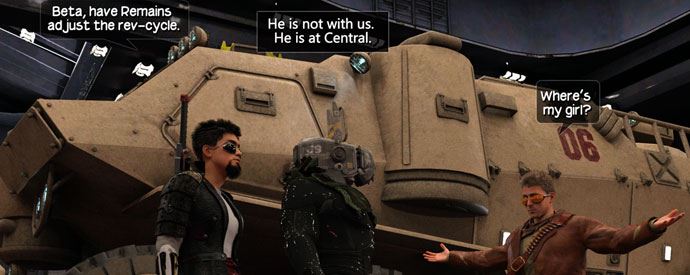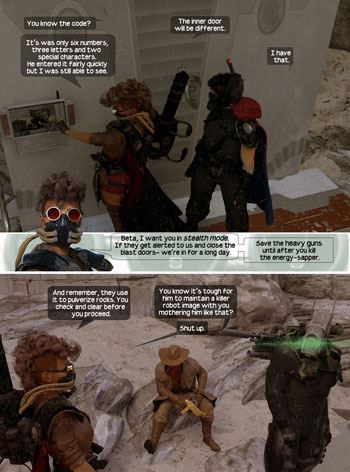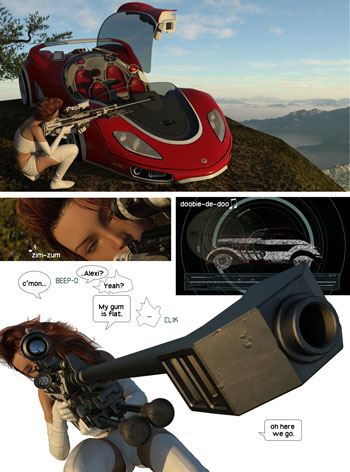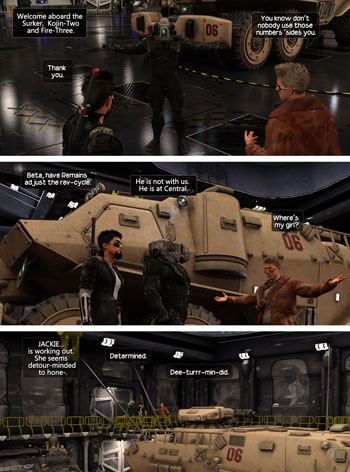Interviews
Interview with Drew Spence

By Hervé St-Louis
July 26, 2017 - 22:27
ComicBookBin: Hi Drew. I think that we have a good start for an interview here! (the interview started in the middle of a conversation!)
Interview? I'd better choose my words more carefully then.
Now that I've read the whole, thing, damn that's wordy. Might have to make a part I and part II. lol
CBB: Tell me, how do you feel about 3D comics in the sense of the reaction that people have to them.
Well, it varies. I've heard all types of comments- how 3D is easier or is fake art or doesn't make real comic books, etc. I take those kinds of statements as different than opinion-based reactions like "I prefer..." or "I dislike..." Someone is speaking as an authority and trying to convince me of an empirical truth whereas, the evidence actually points to the opposite. I draw too. Anyone can draw a comic. Anyone can color a page and anyone can throw some word bubbles across a panel and thus, 'make a comic'. But what some like to do, is draw (no pun) from the greatest masters and legends of 2D work and compare that to the kid who just made his first 3D comic piece and go "See the difference?" It's a silly exercise and your taste really needs no justification. Like what you like and support the work that you feel is meaningful no matter the chosen medium. If it speaks to you, listen. If it doesn't, find the right conversation.
3D has established itself quite well in animation and even visual effects yet still has not made an important breakthrough in comics. Why do you think that is and how do you intend to change this?
A breakthrough is code-word for a big financial success after a big promotional campaign. That would require a book that doesn't look like or work like traditional comics being pushed by the very same entities who'd have a lot to lose if something too different comes along and catches on. Until they have an engine in place, prepared to capitalize on a 3D trend, you won't see any risk-taking or support from the major 2D players.
Established comics tend to have separate writers and artists, if not a whole team. The grass-roots3D is still so new and experimental, that for most, it's still a one-creator show. When I look at many of the 3D books on offer, I find - either the graphics or the story has a challenge. So you have these wonderful illustrations doing uninteresting stuff or a great narrative hampered by the rough visuals. Somebody needs to get both parts right. And enough people need to make solid work so that it creates a wave, even if a single artist breaks first and everyone else follows.
All I can do is my part. I create a 3D comic to the best of my sensibilities and hope the readers enjoy it. I consider myself a storyteller first and illustrator second. I don't want a book that is only worth your time because it looks cool or novel. But, we are telling stories in a very visual medium so I can't have the limitations of my imagination or skill get in the way of the narrative.
CBB: Would you argue that 3D comics suffer from the same hyper realism fate as photo-comics?
The goal of my 3D work is not to fool you or show you 'better looking images'. When still pictures serve as the foundation, you tend to lose the comic part. What's a comic book- other than an exaggeration of a moment or event? Everything is pushed to its limits: fast is the fastest, strong is the strongest, evil is the most evil, etc. Hyper-real is the opposite. If the goal is to tell a fantastic story with extraordinary visuals, why would an artist choose the most faithful medium possible- a snapshot? It actually doesn't make sense. An artist needs to control the visual punctuation. When and how do I underline? Where's the ellipsis pause? How do I boldface and add punctuation marks? We know what to do in the bubbles, it's important to control the volume and tone with the artwork as well.
 |
And the opposite happens in the quiet moments. Can you capture a dynamic moment at rest? Sometimes, the inclusion of details is exactly what taps your emotion. The faithful representation of an idealized moment becomes that much more meaningful. Look at the work of comic legends John Byrne and Barry Windsor-Smith. So much happens when their characters are at rest. The weight, the posing, the heroes' presence in a static backdrop. That's where you need to understand the concepts of good photography along with all the tricks that come after. That's hard to do in any photo-based engine without pre-planning or awareness.
CBB: Which 3D app do you use to render the shots?
DAZ STUDIO is the foundation. It is a free 3d rendering suite - backed by their online store, where you can purchase a massive variety of content for every genre and interest you can imagine. For comic enthusiasts, the look can be edited through shaders, which are basically filters to achieve every comic look you could want. There are morphs that can make characters look very Pixar-like or idealized like the Marvel and DC superheroes.
For traditional artists, it's used for anatomical reference and a drawing aide for perspective and composition. Some draw on top of the models and figures and sketch directly from the template. There are licenses for video game programmers and even some tools for animation.
The engine is really there for you to customize and you can get as deep as you want. Many digital artists do the photoreal stuff where you can't tell if it's CGI or Photoshop. You'll see Daz at work for book covers, movie posters, story boards, but I make use of what it offers for comic illustration. You just need to remember Daz won't make your artwork for you. It's an incredibly powerful environment that places the tools in your hands, but you still need to learn the proper techniques and apply your creative talents. 3D is still not a shortcut for being an artist, it's just a medium.
CBB: What's your production process?
Working in 3D is more like film making where I create the characters. Dress them, make a set. Place them, do lighting and such, place a camera and snap a picture.
From there it's all post-editing. And way after- assemble the book from all the artwork. I can work panel by panel or page by page. It's all design decisions. My eye and taste is really what I lean on. I'm no graphic expert and I will always push and experiment. What does this do? How can I use this tool differently? What if I...
CBB: I'd like to know more about the current story that you are developing and how it fits in the greater picture of past or current work being developed by your team.
Force Six, The Annihilators is meant to combine all the things that I'm passionate about. That's why I made the world so open-ended. Almost anything can happen. My story-telling style has the rules set in place, but we have lots of creative and visual freedom. I create many types of music so I added a soundtrack and I will be venturing into video and other 3D forms to continue telling stories.
Force Six, The Annihilators was something I started drawing back in 1984. Yep 1984 as a kid. I kept all my drawings and now, years later I'm redoing all the stories with very minor edits. In the beginning it was very silly and derivative of whatever I was into at the time. Over time, I kept adding more adult sensibilities and their world grew darker. This series is about fleshing it all out and telling the story from the beginning, well almost the beginning.
CBB: Anything else?
Yes, thank you for your time and thank you for all the readers and supporters for helping us spread the Annihilator graphic comic. We have some awesome stuff coming up, keep turning those pages.
-------------------------------------------------
Drew Spence is a graphic comic writer and illustrator from the United States. He creates under the title The Dynamic Universe. He is both interested in music and video and has created several works, including the Mark of the Griffin, both a graphic novel and web series. The instrumental group fallout Shelter provides the soundtrack for many of his releases. The band members are Domino grey, Dynamics Plus and Xodus Phoenix. He currently lives on Long Island, New York and produces his work from the aptly named Fallout Shelter studios, where he crafts crafty and clever comics using CGI and photorealistic image manipulation.
Purchase Issue #1 of Force Six, The Annihilators at Comixology.
Last Updated: March 3, 2025 - 20:40



